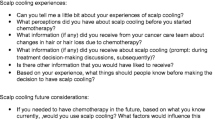Abstract
Background
Chemotherapy-induced alopecia is a common and distressing adverse event for patients. Scalp cooling to reduce this alopecia has been available in Europe for more than a decade, but only recently introduced in Australia. The aim of this study was to qualitatively explore health professionals’ perceptions of the barriers and enablers to the implementation of scalp cooling in Australian cancer centres.
Methods
Using a qualitative methodology, telephone interviews were conducted with 21 health professionals working in a tumour stream where chemotherapy-induced alopecia is an adverse event of treatment. Participants were recruited from five centres in Australia where scalp cooling is currently available and one centre without access to the technology.
Results
Four interrelated themes were identified: (1) health professional attitudes, (2) concerns for patient equity, (3) logistical considerations and (4) organisational support.
Conclusions
This qualitative study provides the first methodological exploration of Australian health professionals’ perceptions of barriers and enablers to scalp cooling uptake. The results highlighted health professional support drives the introduction of scalp cooling. Integration of the technology requires adjustments to nursing practice to manage the increased time, workload and change in patient flow. Strategies to manage the change in practice and organisational support for change in work flow are essential for successful implementation into routine care.
Similar content being viewed by others
References
McGarvey EL, Baum LD, Pinkerton RC, Rogers LM (2001) Psychological sequelae and alopecia among women with cancer. Cancer Pract 9:283–289
Mulders M, Vingerhoets A, Breed W (2008) The impact of cancer and chemotherapy: perceptual similarities and differences between cancer patients, nurses and physicians. Eur J Oncol Nurs 12:97–102
Lemieux J, Maunsell E, Provencher L (2008) Chemotherapy-induced alopecia and effects on quality of life among women with breast cancer: a literature review. Psycho-Oncology 17:317–328
Shaw J, Baylock B, O’Reilly A et al (2016) Scalp cooling: a qualitative study to assess the perceptions and experiences of Australian patients with breast cancer. Supp Care Cancer 24:3813
Jayde V, Boughton M, Blomfield P (2013) The experience of chemotherapy-induced alopecia for Australian women with ovarian cancer. Eur J Cancer Care 22:503–512
van den Hurk CJG, Winstanley J, Young A, Boyle F (2015) Measurement of chemotherapy-induced alopecia—time to change. Supp Care Cancer 23:1197–1199
Protière C, Evans K, Camerlo J, d'Ingrado MP, Macquart-Moulin G, Viens P, Genre D (2002) Efficacy and tolerance of a scalp-cooling system for prevention of alopecia and the experience of breast cancer patients treated by adjuvant chemotherapy. Supp care cancer 10:529–537
van den Hurk CJ, Peerbooms M, van de Poll-Franse LV, Nortier JW, Coebergh JWW, Breed WP (2012) Scalp cooling for hair preservation and associated characteristics in 1411 chemotherapy patients-results of the Dutch scalp cooling registry. Acta Oncol 51:497–504
Betticher DC, Delmore G, Breitenstein U, Anchisi S, Zimmerli-Schwab B, Müller A, Trueb RR (2013) Efficacy and tolerability of two scalp cooling systems for the prevention of alopecia associated with docetaxel treatment. Supp Care Cancer 21:2565–2573
Breed WP, van den Hurk CJG, Peerbooms M (2011) Presentation, impact and prevention of chemotherapy-induced alopecia: scalp cooling potentials and limitations. Expert Rev Dermatol 6:109–125
Shin H, Jo SJ, Kim DH, Kwon O, Myung SK (2015) Efficacy of interventions for prevention of chemotherapy-induced alopecia: a systematic review and meta-analysis. Int J Cancer 136:E442–E454
Belum VR, de Barros Silva G, Laloni MT et al (2016) Breast Cancer Res Treat 157:395. doi:10.1007/s10549-016-3799-7
van den Hurk CJG, Breed WPM, Nortier JWR (2012) Short post-infusion scalp cooling time in the prevention of docetaxel-induced alopecia. Support Care Cancer 20:3255–3260
Mols F, van den Hurk CJ, Vingerhoets AJ, Breed WP (2009) Scalp cooling to prevent chemotherapy-induced alopecia: practical and clinical considerations. Supp Care Cancer 17:181–189
Kitson A, Harvey G, McCormack B (1998) Enabling the implementation of evidence based practice: a conceptual framework. Qual Health Care 7:149–158
Graham ID, Logan J, Harrison MB, Straus SE, Tetroe J, Caswell W, Robinson N (2006) Lost in knowledge translation: time for a map? J Contin Educ Health Prof 26:13–24
Corbin J, Strauss A Basics of qualitative research. Techniques and procedures for developing grounded theory. 3 ed. 2008. Thousand Oaks: Sage Pubications Inc
Peerbooms M, van den Hurk C, Breed B (2015) Familiarity, opinions, experiences and knowledge about scalp cooling: a Dutch survey among breast cancer patients and oncological professionals. Asia-Pacific J Oncol Nurs 2:35–41
van den Hurk CJ, van den Akker-van Marle ME, Breed WP et al (2014) Cost-effectiveness analysis of scalp cooling to reduce chemotherapy-induced alopecia. Acta Oncol 53:80–87
Author information
Authors and Affiliations
Corresponding author
Ethics declarations
Conflict of interest
The authors declare that they have no competing interest.
Data access
The authors have full control of all primary data and agree to allow the journal to review data if requested.
Rights and permissions
About this article
Cite this article
Shaw, J.M., O’Brien, J., Chua, S. et al. Barriers and enablers to implementing scalp cooling in Australia: a qualitative study of health professionals’ attitudes to and experience with scalp cooling. Support Care Cancer 26, 305–312 (2018). https://doi.org/10.1007/s00520-017-3849-7
Received:
Accepted:
Published:
Issue Date:
DOI: https://doi.org/10.1007/s00520-017-3849-7



